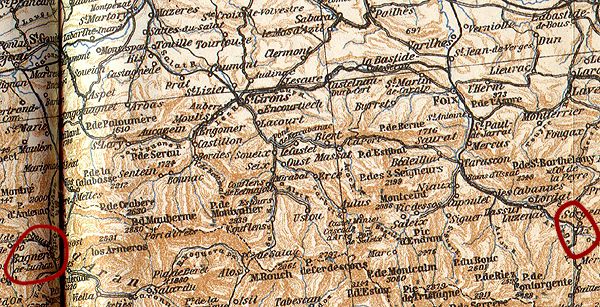|

A Short Tour of the Pyrenees Oriental

2. Ax-les-Thermes to Bagneres-de-Luchon
Mountain towns are often at their best in
the morning: the early sunshine burning off the cloud in the thin air
has a freshness not found at sea level. Ax was no different and we
hobbled (we did say that we were using the Caranca Gorge trip to gauge
our fitness) to sit and enjoy this atmosphere outside a wonderful
old high ceilinged 1920's road side bar, replete with long wooden
counter and enamel signs. With coffee and croissants to hand we watched
a steady stream of motorcycles pass through, presumably on the road to
Andorra. The 1909 Baedeker shows the road only went as far as
Soldeu from where it was possible to follow a bridlepath to Andorra la Vella - which
suggests a road with a lot of bends: not for the last time on this trip, I wished I had
my motorbike with me!
Ax is an odd town, built on the confluence of the Ariege, Oriege and
Lauze rivers and with a profusion of thermal springs it is not surprising that it has a history of settlement as
far back as the Romans but owing apparently to a succession of
disastrous fires no
historical monuments remain. Nevertheless it does have a likable
mountain charm.
Before leaving England we had made a conscious decision to avoid Andorra
as we think there is more to life than tax free shopping and a 12 month
hunting season - so we decided to
take it easy for a day with a leisurely drive west to Bagneres-de-Luchon (hereinafter referred to as
Luchon). Passing through Tarascon, we joined the D618 and ascended to
the Auberge on the Col de Port where we
stopped for a late morning drink. Sitting on the verandah in the warm
sunshine we could see a path winding up the unnamed peak to the South -
and feeling that we should keep our muscles turning over we decided to
climb it. Some 45 minutes later we reached the summit and were rewarded
with a panorama of snow capped peaks
which extended south, east and west. To the north was the valley we had
just climbed from, and beyond: the rolling hills of the Ariege-Pyrenees.
The view gave us a real sense of being right on the northern edge of the
Pyrenees.
Back in the car we continued on into the Ariege region, the road
descending alongside the river Salat. Occasionally the gorge was so
narrow that the road was forced through a succession of crude tunnels - the
first of which caused some alarm, as with little warning we plunged from
dazzling sunlight into a narrow dark rocky cave: during an unpleasant
moment we screeched to a halt in the middle of the road whilst I tried
to find the lights - the prescription sunglasses I was wearing didn't
seem to help much.
Just beyond Saint-Girons we arrived in the ancient town of Saint-Lizier,
its high walls hiding an eleventh century church and some expensively
restored half timbered houses set amongst tiny
alleyways and arcades - the Pyrenees visible to the South. At the
time we visited the streets were virtually empty (and the Restaurant was
closed!) and despite the odd ramshackle building we got the feeling that
this is an exclusive place to live.
We were beginning to realise how important the rivers of the Pyrenees
were in driving transport into the mountains - since leaving Perpignan
heading west the river valleys had become more and more vast. Joining
the Garonne at Saint-Gaudens, the valley was big enough to hold a
motorway, not that the we needed one as we swept in Luchon on the
perfectly adequate D125. We found a hotel and after wandering up
and down the tree lined Allee d'Etigny we treated ourselves to a
splendid three course meal (I had rabbit with a mustard sauce!) washed
down with a pleasant bottle of Cotes de Roussillon.
next: 3. Around
Bagneres-de-Luchon
|

